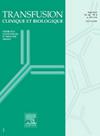The impact of isotonic applied muscle tension in reducing the vasovagal event in first-time blood donors: A cohort study
IF 1.2
4区 医学
Q4 HEMATOLOGY
引用次数: 0
Abstract
Background and objectives
Prevention of vasovagal events has been a major concern for blood centres to reduce the negative impact of decreased donor return for whole blood donation. This study aims to find out the effectiveness of applied muscle tension in reducing vasovagal events in first-time blood donors.
Materials and methods
This cohort study involves the active application of applied muscle tension given by the donor with an inbuilt mechanism through an adjustable spring-fitted footrest in the blood donor couch (Remi India Pvt. Ltd). The outcome measure was encountering vasovagal events from the beginning of whole blood donation till at least 15 min of the observation period after blood donation in the blood donation complex. Vasovagal events were monitored objectively by measuring heart rate and blood pressure before, during whole blood donation, and after recovery from vasovagal events. Various signs of VVRs, such as dizziness, facial pallor, and sweating, were taken into consideration.
Results
This study includes the observation of adverse donor events among first-time blood donors in a total of 2192 whole blood donations. The vaso-vagal events were associated significantly with the muscle tension applied, education, and anxiety level of the blood donors. The regression analysis showed the muscle tension applied, education level, anxiety scale, hemoglobin percentage, volume of blood collected and BMI as an independent predictor of adverse vaso-vagal events in whole blood donation.
Conclusion
Applied muscle tension is an effective tool to reduce the incidence of VVRs in first-time blood donors. Pre-donation counseling of first-time donors may reduce the anxiety level and, in turn, the VVRs.
初次献血者应用等张肌张力降低血管迷走神经事件的影响:一项队列研究。
背景和目的:预防血管迷走神经事件一直是血液中心关注的主要问题,以减少献血者返回全血减少的负面影响。本研究旨在发现应用肌肉张力在减少首次献血者血管迷走神经事件中的有效性。材料和方法:这项队列研究包括献血者主动施加肌肉张力,通过献血者躺椅上的可调节弹簧脚踏板内置机制(Remi India Pvt. Ltd)。结果测量是在献血中心从全血开始到献血后至少15分钟的观察期内遇到血管迷走神经事件。血管迷走神经事件通过在献血前、全血期间和血管迷走神经事件恢复后测量心率和血压进行客观监测。vvr的各种症状,如头晕、面部苍白和出汗,都被考虑在内。结果:本研究对2192例全血首次献血者的不良献血者事件进行了观察。血管迷走神经事件与献血者施加的肌肉张力、受教育程度和焦虑程度显著相关。回归分析显示,应用肌肉张力、受教育程度、焦虑量表、血红蛋白百分比、采血量和BMI是全血捐献中血管迷走神经不良事件的独立预测因子。结论:应用肌肉张力是降低首次献血者vvr发生率的有效手段。对首次献血者进行捐献前咨询可能会降低焦虑程度,进而降低vvr。
本文章由计算机程序翻译,如有差异,请以英文原文为准。
求助全文
约1分钟内获得全文
求助全文
来源期刊
CiteScore
2.50
自引率
11.80%
发文量
234
审稿时长
36 days
期刊介绍:
Transfusion Clinique et Biologique, the official journal of the French Society of Blood Transfusion (SFTS):
- an aid to training, at a European level
- the only French journal indexed in the hematology and immunology sections of Current Contents
Transfusion Clinique et Biologique spans fundamental research and everyday practice, with articles coming from both sides. Articles, reviews, case reports, letters to the editor and editorials are published in 4 editions a year, in French or in English, covering all scientific and medical aspects of transfusion: immunology, hematology, infectious diseases, genetics, molecular biology, etc. And finally, a convivial cross-disciplinary section on training and information offers practical updates.
Readership:
"Transfusers" are many and various: anesthetists, biologists, hematologists, and blood-bank, ICU and mobile emergency specialists...

 求助内容:
求助内容: 应助结果提醒方式:
应助结果提醒方式:


